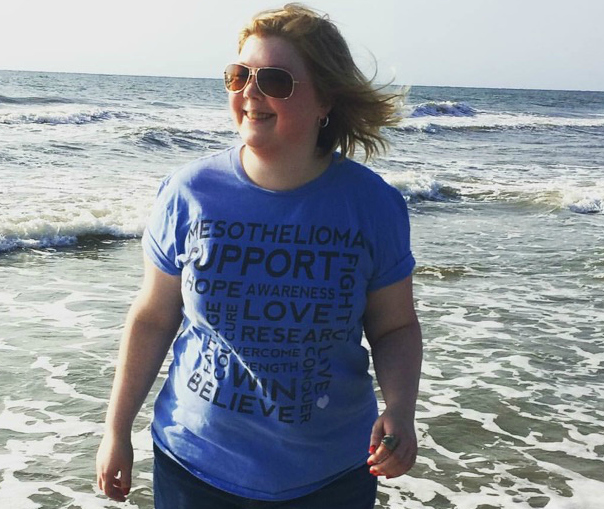15-Year Mesothelioma Survivor Living Life By Design

Fact Checked | Written by: Matt Mauney | Last Update: 10/25/2024 | 7 Min Read
Diagnosed with peritoneal mesothelioma at age 15, Alyssa Hankus’ adolescence was anything but normal.
She missed nearly her entire freshman year of high school and spent much of her sophomore and junior years in and out of hospitals dealing with the effects of aggressive cancer treatments.
“I wanted everything that wasn’t necessarily promised to me at that point in time,” Hankus told Asbestos.com. “I wanted to go to school and get married and have kids and to grow old and have grandkids. All of these different things, I wasn’t going to take no for an answer.”
The 15-year mesothelioma survivor, who is now 30, is making good on some of those goals.
Despite all the missed classroom time, Hankus graduated high school in four years. She later earned a bachelor’s degree in interior architecture from UNC Greensboro and recently got her first job in the industry, designing eating spaces for colleges, restaurants, businesses and health care facilities.
For a moment, she considered nursing as a way to give back, but her passion has always been design.
“I thought maybe I could give back in that way through hospital design,” she said. “Being in there for as long as I was, it’s a way to make it better for all those involved — patients, doctors, what have you.”
Hankus hopes the position can be a stepping stone to one day designing patient rooms, as a way to touch the lives of patients and make them feel as comfortable and “at home” as possible when facing an illness.

Alyssa Hankus with her boyfriend, Eric.
Outside of her career, Hankus enjoys spending time with friends and her three young nephews. She looks forward to a future with her boyfriend in hopes of having kids and starting the next chapter of her life.
“It’s all a part of that continued fight of making it and achieving all of the things that at 15 I was told I never would,” she said. “Those little day-to-day simple joys are what mean so much, because those were never promised to me.”
Hankus’ Diagnosis Defies the Odds
Mesothelioma has a long latency period, meaning it typically takes years — often decades — between a patient’s initial exposure to asbestos and the development of symptoms.
The overwhelming majority of cases are diagnosed at ages 75 to 84.
“My doctors told me it takes at least 15 years to present symptoms, but I actually started showing symptoms around age 12,” Hankus said.
She hasn’t been able to pinpoint when or where her asbestos exposure occurred — a common issue for women who don’t fit the traditional mesothelioma patient profile of older men who worked high-risk jobs.
At the time of her diagnosis, Hankus was told she was one of 10 children in the world diagnosed and only the second to survive.
“I’m sure there are more out there, but all of the survivors I’ve met are adults,” she said. “It is just so rare in children.”
Because of the incredible odds, Hankus didn’t receive her mesothelioma diagnosis until three years after she began showing symptoms.
“The doctors thought that it was just growing pains, because it wasn’t that severe at first,” she said.
Stomach Lining ‘Twisted Like a Dish Rag’
In the fall of her eighth-grade year, the pain intensified to the point where her mom had to rush her to the hospital.
“They thought at first that it was my appendix because of where the pain was located,” Hankus said.
During an appendectomy, doctors discovered a troubling sight.
“The lining of my stomach was twisted like a dish rag,” she said.
Doctors removed part of the lining attached to the back of the appendix but still couldn’t determine the underlying issue.
The pain continued, which eventually led Hankus to Johns Hopkins Hospital in her hometown of Baltimore, Maryland. Pediatric physicians there determined she had irritable bowel syndrome and prescribed a corticosteroid that unfortunately made her undiagnosed cancer grow faster, causing more pain.
In October 2001, Hankus agreed to an exploratory surgery at Hopkins, but the pediatric surgeon involved had never seen mesothelioma before. An oncologist who specializes in adults later delivered the diagnosis.
‘I Give It to God’
Hankus’ treatment plan started with chemotherapy, but it was too much for her young body to take.
“They were initially going to do six rounds of chemotherapy but were only able to do three because it was killing me,” she said. “I wasn’t even able to keep ice cubes down. I was throwing up everything and losing a ton of weight.”
Making matters worse, Hankus came down with a case of fungal pneumonia.
“Everything was fighting against my body,” she said.
The next option became exploratory surgery and hyperthermic perioperative chemotherapy (HIPEC). Hankus transferred to the National Institutes of Health in Bethesda, Maryland, and she was placed under the care of Dr. Richard Alexander, an internationally recognized surgical oncologist who specializes in treating abdominal cancers.
A week before her procedure in 2002, a CT scan revealed what doctors called a “complete snowstorm” around the lining of her stomach. They determined the mesothelioma cancer was in the most advanced stage.
Doctors released Hankus for the week to celebrate Easter with her family. It was her first holiday home from the hospital in five months.
When surgery day arrived, the unexplainable happened. The expected 10-hour surgery took only half that time. Alexander had to respond to an emergency, putting Hankus’ operation in the hands of another surgeon.
“My family and people from our church were together praying, so the doctor waited to let them finish praying and give them the news,” Hankus said. “He told them the lining was pristine, that there were only three acorn-sized tumors and two microscopic specs.”
The rest was clean. There was no “snowstorm” as previously described. Hankus’ surgical team couldn’t explain it. Years later, the lead surgeon told her that he didn’t expect she’d make it off the operating table that day.
“Honestly, I give it to God,” Hankus said. “To have such a different outcome and such little evidence of the mesothelioma, no one could explain with science.”
‘One Miracle After Another’
Although the surgery went far better than expected, Hankus experienced residual pain for two years.
Return visits to NIH became frequent.
“They tried all kinds of things like acupuncture and hypnosis and just kept increasing the narcotics, trying to get rid of the pain and not knowing what the source of it was,” she said.
Hankus was eventually able to get on an adult program back at Johns Hopkins. Doctors there planned to get her off the high dosages of pain medications through three weeks of in-patient care and six weeks of out-patient care.
During the first few weeks of the program, doctors agreed to let Hankus’ parents take her to a healing service led by evangelical minister Kenneth Copeland and his wife, Gloria.
“Gloria Copeland laid her hands on me and the pain went away that night and never came back,” Hankus said. “I was able to get off the medicine without any withdrawal symptoms. Doctors couldn’t explain it. It’s just been one miracle after another.”
She was able to return to high school, but it took a toll on her immune system, which was readjusting to life outside of a hospital room. After graduating, the adjustments continued through community college.
“It took me about four years to get a two-year degree, only because my stamina was too low,” she recalled.
In her last year at the community college, Hankus challenged herself, taking on more classes and joining clubs to prepare her body and mind for the rigors she would face in the interior design program at UNC Greensboro.

Alyssa Hankus with her parents after graduating from UNC Greensboro.
“I wanted to prove to myself that I could do it,” she said.
She did and is now living her dream as a designer. Her next milestones: Marriage and starting a family.
Now 15 years in remission, she hopes her story will inspire other survivors and raise more awareness that mesothelioma doesn’t only affect older men.
“A big part of your survival is your mindset,” she said. “I’m just trying to make the most of a future that wasn’t promised to me.”





